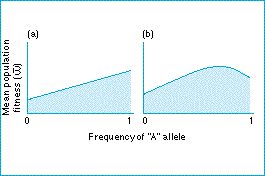Multi-locus population genetics - What is an adaptive topography?

Adaptive topography
Wright's idea of an adaptive topography is particularly useful for thinking about complex genetic systems. It is easier to begin with the simplest case. This is for a single genetic locus. The topography is a graph of mean population fitness against gene frequency.
In a case in which the genotypes containing one of the alleles have higher fitness than those of the alternative, the mean fitness of the population simply increases as the frequency of the superior allele increases and reaches a maximum when the gene is fixed, as in figure (a). When there is heterozygous advantage, mean fitness is highest at the equilibrium gene frequency. It declines on either side, where more of the unfavorable homozygotes will be dying each generation than at the equilibrium - figure (b).
In these two cases, natural selection carries the population to the gene frequency where mean fitness is at a maximum.
Figure: a fitness surface, or adaptive topography, for (a) directional selection for allele A and (b) heterozygous advantage for the Aa genotype.
| Next |



